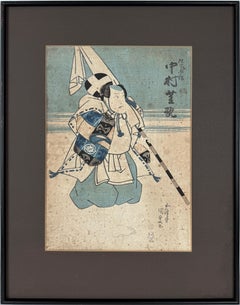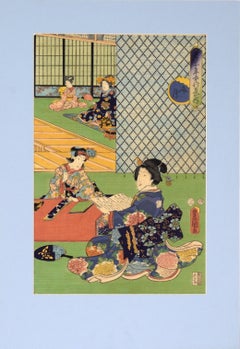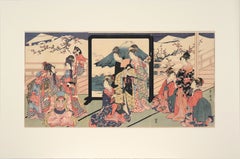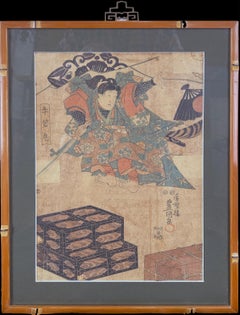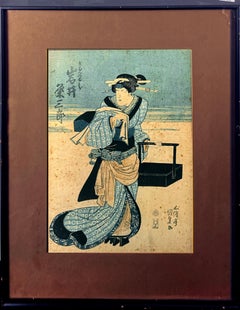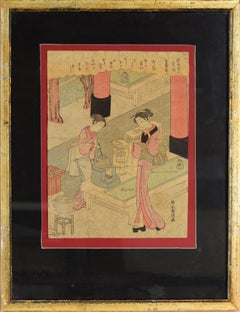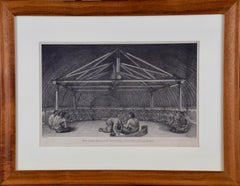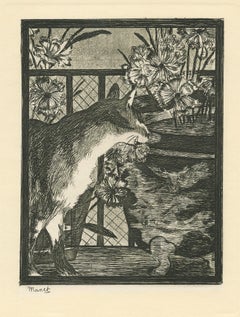Rice Paper Interior Prints
to
7
1
5
2
Overall Width
to
Overall Height
to
4
1
2
5
1
2
6
2
8
5
3
3
2
2
2
2
1
1
231
600
519
341
278
4
8
Medium: Rice Paper
Kabuki actor Nakamura Shikan II by Utagawa Kunisada Edo Japanese Woodblock Print
Located in Soquel, CA
Kabuki actor Nakamura Shikan II by Utagawa Kunisada Japanese Woodblock Print
Wonderful portrait of Nakamura Shikan II, a prominent kabuki actor, in the role of Kisen Hoshi Toyokuni ...
Category
1820s Realist Rice Paper Interior Prints
Materials
Printer's Ink, Rice Paper, Woodcut
Annual Events for Young Murasaki (July) - Tales of Genji - Japanese Woodblock
Located in Soquel, CA
Annual Events for Young Murasaki (July) - Tales of Genji - Japanese Woodblock
Rightmost panel a triptych, depicting monthly events for Wakamurasaki (Young Murasaki). This is the month of July. There appears to be a lesson taking place, possibly for writing or poetry.
Artist: Toyokuni III/Kunisada (1786 - 1864)
Publisher: Ebisu-ya Shoshichist
Presented in a new blue mat.
Mat size: 19"H x 13"W
Paper size: 14.5"H x 10"W
Commentary on the triptych:
In the Edo period, Tanabata was designated as one of the five seasonal festivals, and became an annual event for the imperial court, aristocrats, and samurai families, and gradually came to be celebrated by the general public. Its origins are said to be a combination of the Kikoden festival, which originated from the Chinese legend of Altair and the Weaver Girl, and Japan's ancient Tanabata women's faith. Ink is ground with dew that has accumulated on potato leaves, poems and wishes are written on five colored strips of paper, which are then hung on bamboo branches to celebrate the two stars that meet once a year. Although the illustration is a Genji painting...
Category
1850s Realist Rice Paper Interior Prints
Materials
Printer's Ink, Rice Paper, Woodcut
"Toy Horse Dance" Japanese Woodblock Triptych with Beauties and Mt Fuji
Located in Soquel, CA
"Toy Horse Dance" Japanese Woodblock Triptych with Beauties and Mt Fuji
Vibrant three-panel woodblock print by Utagawa Toyohiro (Japanese,...
Category
Early 20th Century Edo Rice Paper Interior Prints
Materials
Ink, Rice Paper, Woodcut
Kumasaka Chōhan to Ushiwakamaru - One of a Diptych Original Woodcut Print
Located in Soquel, CA
Kumasaka Chōhan to Ushiwakamaru is a Japanese Ukiyo-e print created between 1848 and 1854 by artist Utagawa Kunisada (Japanese, 1786-1864). The print is a Diptych, and is part of the...
Category
1850s Realist Rice Paper Interior Prints
Materials
Printer's Ink, Rice Paper, Woodcut
Ichimura Uzaemon XIII - actor as Okaji of Gion, 1862 "The Six Poetry Immortals"
Located in Soquel, CA
Ichimura Uzaemon XIII - actor as Okaji of Gion, 1862 "The Six Poetry Immortals"
A Japanese Ukiyo-e woodcut print created circa 1862 by artist Utagawa Kunisada (Japanese, 1786-1864). ...
Category
1850s Realist Rice Paper Interior Prints
Materials
Printer's Ink, Rice Paper, Woodcut
Deutzia Flowers: The Wife of Kasamori - Original Woodblock Print
Located in Soquel, CA
Deutzia Flowers: The Wife of Kasamori - Original Woodblock Print
Deutzia Flowers: The Wife of Kasamori, from the Series "Beauties of the Floating World Associated with Flowers" by S...
Category
1760s Edo Rice Paper Interior Prints
Materials
Woodcut, Ink, Rice Paper
$720 Sale Price
20% Off
No. 45, View of Akasaka from "Comical Views of Famous Places in Edo" Woodblock
Located in Soquel, CA
No. 45, View of Akasaka from "Comical Views of Famous Places in Edo" Woodblock
Whimsical woodblock print by Utagawa Hirokage (Japanese, active 1855–1865). Four people are sitting on...
Category
1860s Edo Rice Paper Interior Prints
Materials
Rice Paper, Woodcut
"House Cleaning in Preparation for the New Year" - Japanese Woodblock on Paper
Located in Soquel, CA
"House Cleaning in Preparation for the New Year" - Japanese Woodblock on Paper
House cleaning scene by Kitagawa Utamaro (Japanese, 1753-1806). This print was originally published around 1796-1799, with this example being a later reprint. The full scene is five sheets - there are two more sheets to the right that show more members of the house. However, it is these three sheets that contain the majority of the action - a maid sweeping at a mouse, a lady fainting, and a painting moved aside to allow for cleaning.
Presented in a new black mat.
Mat size: 24"H x 38"W
Paper size: 17.75"H x 33"W
Print Impression: 14.63"H x 29.5"W
Utamaro Kitagawa...
Category
18th Century Edo Rice Paper Interior Prints
Materials
Rice Paper, Woodcut
Related Items
"King of the Friendly Islands" (Tonga); Engraving from Captain Cook's 3rd Voyage
By John Webber
Located in Alamo, CA
"Poulaho, King of the Friendly Islands, Drinking Kava" is an engraving created by William Sharp (1749-1824), from a drawing by John Webber (1752-1793), who was the artist on Captain James Cook's 3rd and final voyage of discovery. It was published in the atlas of "A Voyage to the Pacific Ocean Undertaken by the Command of His Majesty, for Making Discoveries in the Northern Hemisphere", the official British Admirality sanctioned journal published upon completion of the voyage in London in 1784 by Strahan & Cadell.
Captain Cook visited Tonga on his 3rd voyage, which he named The Friendly Islands because of the warm welcome he and his crew received, unlike some of the other more hostile Pacific islands. The engraving depicts Cook and his men observed a kava ceremony at the village of Mu’a on Tongatapu. King Paulaho sits in the centre foreground, his back to the spectator with a man kneeling before him. The ceremonial mat depicted behind Paulaho indicates that nobody was allowed to sit behind him. The figure in the centre holds a single cup, referring to the Tongan custom of offering the cup to the king first. Kava is native to the islands of the South Pacific and was first described for English readers in 1768 by Captain James Cook. The kava root has been used for centuries as a central feature of ceremonies and celebrations because it was able to bring about a calming and pleasant social atmosphere. The root was crushed and processed into coconut milk to become the focal ceremonial beverage, simply referred to as kava.
This engraving is presented in a Koa wood frame and a white mat. Koa wood is legendary in Hawaii. There are occasional faint spots, but the print is otherwise in very good condition. This amazing Koa wood is native to Hawaii and it is known for the deep rich colors and varied grain pattern. Koa has an honored heritage in Hawaii and is highly revered and sacred. The word “koa” means “warrior” in Hawaiian. The warriors of King Kamehameha the Great, created canoes and weapons from a wood plentiful on the Big Island of Hawaii. This wood became synonymous with the warriors themselves, and it became known as koa.
There are three other engravings listed from the official journal of Captain Cook's 3rd voyage available that are presented in identical Koa wood frames and mats (LU117324682422, LU117324684052, LU117324684032). They would make a wonderful grouping for a display of 2, 3 or 4 prints. A discount is available for a grouping depending on the number of items included.
Captain Cook is remembered as one of the greatest explorers and navigators in history. His explorations included Australia, New Zealand and islands of the South Pacific and the northwest coast of North America. Hawaii was discovered by Captain Cook during this voyage. Hawaii was originally called The Sandwich Islands in honor of The Earl of Sandwich...
Category
1780s Realist Rice Paper Interior Prints
Materials
Engraving
$2,375
H 18.25 in W 23.5 in D 0.88 in
Le Chat et Les Fleurs
Located in Middletown, NY
Etching and aquatint on cream laid, watermarked Rives paper. 6 5/8 x 5 inches (167 x 126 mm). Sixth and final state, a posthumous impression. A fine, inky impression with full margin...
Category
1860s Realist Rice Paper Interior Prints
Materials
Aquatint, Etching
The Lonely House at Asajigahara.
Located in Middletown, NY
A scene from a series of ghost stories and spooky rural legends.
Tokyo: Matsuki Heikichi, 1896.
Woodcut in ink with embossing and hand-coloring in watercolor on handmade mulberry pa...
Category
Late 19th Century Edo Rice Paper Interior Prints
Materials
Watercolor, Handmade Paper, Woodcut
Two Women Playing Sugoroku from "Comparison of the Customs of Beauties."
Located in Middletown, NY
A scene from a vanishing Japan.
Two Women Playing Sugoroku from "Comparison of the Customs of Beauties."; The Customs and Manners of Women
Japan: Matsuki Heikichi, 1891.
Woodblock ...
Category
Late 19th Century Edo Rice Paper Interior Prints
Materials
Watercolor, Handmade Paper, Woodcut
$450
H 12.75 in W 8.63 in
Scene Galante au XVIII eme Siecle #1
Located in San Francisco, CA
This artwork titled "Scene Galante au XVIII eme Siecle" c.1930 in an aquatint on paper by French artist Antoine Calbet, 1860-1944. It is hand signed in pencil at the lower right corner. The plate mark (image) size is 9.60 x 12.25 inches, framed size is 16.5 x 19.5 inches. Framed in a wooden gold and black frame, with fabric matting. The artwork is in very good condition, frame and matting are in good condition, frame have some minor dents, matting have a small point of discoloration at upper left.
About the artist.
Antoine Calbet is the son of Marie Singlande and Jean-Baptiste Calbet, landowner at a place called Gaubert.
Trained at the School of Fine Arts in Montpellier by Édouard - Antoine Marsal (1845-1929) where he learned drawing, this illustrator and illustrator, a painter of nudes and gallant scenes, was very popular during his lifetime.
Antoine Calbet is then admitted to the School of Fine Arts in Paris in the studio of Alexandre Cabanel (1823-1889). He was a member of the admission jury of the Beaux-Arts from 1913 to 1930. He began to exhibit in 1880 and became a member of the Society of French Artists . He was the friend of his compatriot of Lot-et-Garonne, the President of the Republic Armand Fallières , for which he drew the menus of his meals, which made him known in Parisian salons.He illustrated works by Jean Lorrain , Henri de Regnier , Pierre Loues 3 and for periodicals like L'Illustration .
Selected museums and collections
Dallas , Dallas Museum of Art : Back woman...
Category
Mid-20th Century Realist Rice Paper Interior Prints
Materials
Aquatint
'The Bath' — Meji Era Cross-Cultural Woman Artist
By Helen Hyde
Located in Myrtle Beach, SC
Helen Hyde, 'The Bath', color woodblock print, edition not stated, 1905, Mason & Mason 59. Signed in pencil in the image, lower right. Numbered '96' in pencil in the image, lower left. The artist's monogram in the block, lower left, and 'Copyright, 1905, by Helen Hyde.' upper right. A superb impression with fresh colors on tissue-thin cream Japanese paper; the full sheet with margins (7/16 to 1 5/8 inches), in excellent condition. Matted to museum standards, unframed.
Image size 16 1⁄4 x 10 1⁄8 in. (413 x 260 mm); sheet size: 19 1⁄4 x 11 1⁄8 in. (489 x 283 mm).
Literature and Exhibition: Back cover illustration of the catalog of the artist’s prints, 'Helen Hyde', Smithsonian Institution Press, 1990; 'The International Block Print Renaissance, Then And Now, Block Prints In Wichita, Kansas, A Centennial Celebration — 1922-2022', Barbara J. Thompson, Wichita Art Museum, 2022 (back cover).
Impressions of this work are held in the following collections: Achenbach Foundation for Graphic Arts, Art Institute of Chicago, Fine Arts Museums of San Francisco (De Young), Harvard Art Museums, Library of Congress, Metropolitan Museum of Art, New York Public Library, Smithsonian American Art Museum, Terra Foundation for American Art, University of Oregon Museum of Art.
ABOUT THE ARTIST
Helen Hyde (1868-1919) was a pioneer American artist best known for advancing Japanese woodblock printmaking in the United States and for bridging Western and Japanese artistic traditions. Hyde was born in Lima, New York, but after her father died in 1872, her family relocated to Oakland, California, where she spent much of her youth.
Hyde pursued formal art education in the United States and Europe. She enrolled in the San Francisco School of Design, where she took classes from the Impressionist painter Emil Carlsen; two years later, she transferred to the Art Students League in New York, studying there with Kenyon Cox. Eager to expand her artistic repertoire, Hyde traveled to Europe, studying under Franz Skarbina in Berlin and Raphael Collin in Paris. While in Paris, she first encountered Japanese ukiyo-e prints, sparking a lifelong fascination with Japanese aesthetics. After ten years of study, Hyde returned to San Francisco, where she continued to paint and began to exhibit her work.
Hyde learned to etch from her friend Josephine Hyde in about 1885. Her first plates, which she etched herself but had professionally printed, represented children. On sketching expeditions, she sought out quaint subjects for her etchings and watercolors. In 1897, Hyde made her first color etchings—inked á la poupée (applying different ink colors to a single printing plate)—which became the basis for her early reputation. She also enjoyed success as a book illustrator, and her images sometimes depicted the children of Chinatown.
After her mother died in 1899, Hyde sailed to Japan, accompanied by her friend Josephine, where she would reside, with only brief interruptions, until 1914. For over three years, she studied classical Japanese ink painting with the ninth and last master of the great Kano school of painters, Kano Tomonobu. She also studied with Emil Orlik, an Austrian artist working in Tokyo. Orlik sought to renew the old ukiyo-e tradition in what became the shin hanga “new woodcut prints” art movement. She immersed herself in the study of traditional Japanese printmaking techniques, apprenticing with master printer Kanō Tomonobu. Hyde adopted Japanese tools, materials, and techniques, choosing to employ the traditional Japanese system of using craftsmen to cut the multiple blocks and execute the exacting color printing of the images she created. Her lyrical works often depicted scenes of family domesticity, particularly focusing on women and children, rendered in delicate lines and muted colors.
Through her distinctive fusion of East and West, Hyde’s contributions to Western printmaking were groundbreaking. At a time when few Western women ventured to Japan, she mastered its artistic traditions and emerged as a significant figure in the international art scene.
Suffering from poor health, she returned to the United States in 1914, moving to Chicago. Having found restored health and new inspiration during an extended trip to Mexico in 1911, Hyde continued to seek out warmer climates and new subject matter. During the winter of 1916, Hyde was a houseguest at Chicora Wood, the Georgetown, South Carolina, plantation illustrated by Alice Ravenel Huger Smith in Elizabeth Allston Pringle’s 1914 book A Woman Rice Planter. The Lowcountry was a revelation for Hyde. She temporarily put aside her woodcuts and began creating sketches and intaglio etchings of Southern genre scenes and African Americans at work. During her stay, Hyde encouraged Smith’s burgeoning interest in Japanese printmaking and later helped facilitate an exhibition of Smith’s prints at the Art Institute of Chicago.
During World War I, Hyde designed posters for the Red Cross and produced color prints extolling the virtues of home-front diligence.
In ill health, Hyde traveled to be near her sister in Pasadena a few weeks before her death on May 13, 1919. She was buried in the family plot near Oakland, California.
Throughout her career, Hyde enjoyed substantial support from galleries and collectors in the States and in London. She exhibited works at the St. Louis Exposition in 1897, the Pan-American Exhibition in Buffalo in 1901, the Tokyo Exhibition for Native Art (where she won first prize for an ink drawing) in 1901, the Alaska-Yukon-Pacific Exhibition in Seattle in 1909 (received a gold medal for a print), the Newark Museum in 1913, a solo show at the Chicago Art Institute in 1916, and a memorial exhibition in 1920, Detroit Institute of Arts, Color Woodcut Exhibition in 1919, New York Public Library, American Woodblock Prints...
Category
Early 1900s Showa Rice Paper Interior Prints
Materials
Woodcut
Once upon a time in London, Morning, Woodcut print, Vincent Van Gogh, Sunflowers
Located in Deddington, GB
A limited edition woodcut on paper print by Mychael Barratt of Vincent Van Gogh in his bedroom with his dog. Sunflowers appear in the background, brightening up a blue and purple room.
Additional information:
Mychael Barratt
Once upon a time in London, Morning
Woodcut on paper
Signed and titled in pencil
Numbered from the edition of 100
Image size
Height: 27.5 cm
Width: 27 cm
Complete size of sheet
Height: 39.6 cm
Width: 37.5 cm
Depth: 0.2 cm
ARTIST PROFILE: Mychael Barratt was born in Toronto, Canada, however, considers himself to be a Londoner since arriving for what was supposed to be a two-week stay thirty years ago. He is a narrative artist whose work is steeped in imagery relating to art history, literature, theatre and everything else that overfills his bookshelves. He was an artist in residence for Shakespeare’s Globe Theatre...
Category
2010s Contemporary Rice Paper Interior Prints
Materials
Paper, Woodcut
$453
H 39.6 in W 37.5 in D 0.2 in
THE WAGON SHOP
Located in Santa Monica, CA
GUSTAVE BAUMANN (1881 – 1971)
THE WAGON SHOP, 1910 (Chamberlain 24)
Color woodcut signed in pencil. Unnumbed from an edition 100 as published in the Hills o’ Brown...
Category
1910s Modern Rice Paper Interior Prints
Materials
Woodcut
Jan Oytenbogaert
Located in San Francisco, CA
This artwork titled Jan Uytenbogaert" 1639 is an etching on paper After Rembrandt Van Rijn, 1606-1669, plate engraved By French renown engraver Charles Armand Durand, 1831-1905. Sign...
Category
17th Century Realist Rice Paper Interior Prints
Materials
Etching
College of Physicians, from Ackermann's "Microcosm of London."
Located in Middletown, NY
Pugin, Augustus Charles & Rowlandson, Thomas (after).
College of Physicians, from Ackermann's "Microcosm of London."
London: Rudolph Ackermann, 1808. Hand-colored lithograph, 9 1/4 ...
Category
Early 19th Century English School Rice Paper Interior Prints
Materials
Handmade Paper, Watercolor, Lithograph
19th century etching black and white figurative print female subject signed
Located in Milwaukee, WI
"The Spinner" is an original etching by Jean Leon Gerome Ferris. It depicts a woman in an interior next to a spinning wheel. The artist signed the piece lo...
Category
1880s Realist Rice Paper Interior Prints
Materials
Etching
Poltergeist - Woodcut by Maurits Cornelis Escher - 1932
Located in Roma, IT
Woodcut print from the Series "Der vreeselijke avonturen vas Scholastica" (The Terrible Adventures of Scholastica).
Edition of 300, published by A. J. van Dishoeck.
Unsigned, ass i...
Category
1930s Modern Rice Paper Interior Prints
Materials
Woodcut
$4,313
H 9.02 in W 6.62 in D 0.04 in
Previously Available Items
Early 20th Century Japanese Woodblock -- Woman Looking At Her Sleeping Kamuro
Located in Soquel, CA
Charming early 20th Century Japanese woodblock of woman looking at her sleeping Kamuro (little servant) or "Mother and Daughter" by Edo period artist Harunobu Suzuki...
Category
Early 20th Century Edo Rice Paper Interior Prints
Materials
Ink, Rice Paper
H 20.75 in W 16.85 in D 0.63 in
Rice Paper interior prints for sale on 1stDibs.
Find a wide variety of authentic Rice Paper interior prints available on 1stDibs. While artists have worked in this medium across a range of time periods, art made with this material during the 20th Century is especially popular. There are many well-known artists whose body of work includes ceramic sculptures. Popular artists on 1stDibs associated with pieces like this include and Utagawa Kunisada (Toyokuni III). Not every interior allows for large Rice Paper interior prints, so small editions measuring 0.1 inches across are also available Prices for interior prints made by famous or emerging artists can differ depending on medium, time period and other attributes. On 1stDibs, the price for these items starts at $65 and tops out at $193,754, while the average work can sell for $780.
